VVAM Newsletter 72 – 1998
FRIENDS OF THE AIRBORNE MUSEUM
Editors:Drs. R.P.G.A. Voskuil, C. van Roekel, G.H. Maassen jr.
Newsletter No. 72, October 1998
Representative in Great Britain: Mr. E.E. Shaw, 298 Totnes Road Paignton – Devon TQ4 7HD Tel. 0803-553616

The Reverend J.G. Morrison during his sermon nt the Airborne Cemetery, Oosterbeek, 20 September ‘1998. To his left is Lieutenant Colonel H.B.M. Wanders, chaplain with the Royal Netherlands Air Force. (Photo: Berry de Reus)
Theme afternoon on 31 October 1998
As announced in the March issue of the Newsletter, this year’s theme afternoon will be held on Saturday 31 October 1998 in the Zalencentrum Lebret, Lebretweg 51, Oosterbeek.
The programme is as follows:
13.30 -14.00 hours: members arrive.
14.00 -14.45 hours: lecture by Mr Wybo Boersma entitled ‘Allied prisoners-of-war during the Battle of Arnhem’.
14.45 -15.15 hours: lecture by Mr Marcel Anker entitled ‘The German prisoner-of-war camp Stalag Xl-B in Fallingbostel’.
15.15 -16.00 hours: BREAK.
16.00 -16.45 hours: the showing of video-filmed interviews with former British prisoners-of-war and films made during the liberation of German prisoner- of-war camps in 1945.
Approx. 17.00 hours: end of the theme afternoon.
The afternoon’s theme is connected with the exhibition currently running (up to and including 1 November 1998) in the Airborne Museum ‘Hartenstein’. The weekend of the theme afternoon will be the last opportunity one will have of visiting the exhibition.
Boat trip on the rivers Rhine and Waal
Next year our museum will be fifty years old. This, and the fact that a year later our Society will be celebrating its 20th birthday, have given the board and the excursion commission sufficient reason to organise a festive boat journey for members, museum staff, family and friends.
This day trip will be held on Sunday 16 May 1999. The boat will depart from the Rijnkade in Arnhem, head for Pannerden, and then follow the Waal until just beyond Nijmegen. The boat will turn at the point where parachutists of the 82nd U.S. Airborne Division made their historic river crossing in September 1944. This crossing eventually led to the capture of the bridges over the Waal at Nijmegen. Everyone taking part will receive a comprehensive excursion guide and expert comment will be given on the events of 54 years ago at various points along the way.
As well as having the unique opportunity of viewing historic locations from the river itself, the journey will also allow you to enjoy the beautiful natural scenery which borders the Rhine and the Waal.
For this special occasion, and this is an exception, one may bring along family, friends and partner.
There is room for about 300 people.’Trippers’ will be given coffee and gateaux on departure, and an ‘expansive’ lunch will be served on board.
The cost of the boat trip is 47.50 guilders per person and you can make a reservation using the form that will be enclosed with the next Newsletter. The form will indicate how and when payment for the trip is to be made and will include other information such as place, time and possibilities for car parking.
So, keep Sunday 16 May 1999 free for a pleasant and educative boat journey.
(On behalf of the excursion commission, C. van Roekel)

Pall bearers carry one of the three coffins to its final resting place in the Airborne Cemetery during the reburial of the remains of British soldiers on IS September 199S. (Photo: Berry de Reus)
Re-interment at the Airborne Cemetery
In January 1994 the remains of two British glider pilots were found during excavation work at Sonnenberg in Oosterbeek. Thanks to the efforts of the Dutch Army’s Recovery and Identification Service in Bussum, the British Military Attache, the Commonwealth War Graves Commission and the British Ministry of Defence, it was possible for the remains to be identified. The two glider pilots would appear to be: Sergeant Lawrence Herbert Howes and Sergeant David Thompson, who both died on 20 September 1944.
However, since 1946 grave no 18-A-20 in the Airborne Cemetery has been marked with a headstone bearing the name Lawrence Herbert Howes. It seems that a serious error was made when the body was interred there in 1946. Alas, the British Ministry of Defence will not allow the grave to be opened so that a possible identification of the soldier who lies there can be made. The grave now has a headstone with the inscription ‘A Soldier of the 1939- 1945 War, Known unto God’.
The remains of another British soldier were also discovered in July 1997 in Oosterbeek. This discovery occurred during the laying of telephone cables along the Van Lennepweg, near house no. 14. The soldier was identified as Corporal George Froud of the Border Regiment. He was killed at the spot on 21 September 1944.
The events described above were brought to an impressive conclusion on the afternoon of 18 September 1998. On that afternoon a most unusual two-part ceremony took place at the Airborne Cemetery in Oosterbeek. First, a short service was held at grave number 18-A-20, which is now that of an unknown soldier. This was followed by the final laying to rest with full military honours of Sergeant Howes, Sergeant Thompson and Corporal Froud, with a large number of mourners in attendance. Several family members were also present at the service. What was so extraordinary was the fact that George Froud’s son had only been traced two days previously following an appeal on BBC TV.
The Reverend P.J. Howson, Chaplain to the Forces (Army), conducted the service in a way that deeply moved the entire congregation.
Veterans’ ashes interred
During a short service held on the morning of 18 September 1998, two small caskets containing the ashes of veterans who died earlier this year, Company Sergeant Major George Gatland MBE and Lance Corporal Harold E. Back, were buried at the Airborne Cemetery. The service was led by the Reverend J.G. Morrison MBE, who also conducted the main, general memorial service on Sunday 20 September.
In September 1944 CSM George Gatland was attached to the Support Company of the 11th Parachute Battalion. His aircraft was hit by flak to the west of Wageningen while on the way to the dropping zone at the Ginkelse Heide. Gatland just managed to escape from the aircraft by parachute and later joined up with the rest of the division in Oosterbeek. Every year after the war he was closely involved with the organisation of the commemoration of the Battle of Arnhem.
L/Cpl Harold Back served with the 2nd Parachute Battalion in September 1944. He fought at the bridge where, for the first few days, he and two other soldiers held a strategic position in the attic of Lieutenant Colonel Frost’s headquarters. When the building burned down and they were ordered by Frost to dig-in in the garden, his two comrades were killed.
Back fought on until his ammunition was exhausted, was captured by the Germans and then transported to a camp in Germany. He managed to escape but was recaptured shortly afterwards. He was freed by the Russians in April 1945.
Gift of bench seat from ‘Arnhem Veterans’
Every year since 1945 the schoolchildren of Oosterbeek have laid flowers on the graves in the Airborne Cemetery during the memorial service. As a token of their gratitude, the ‘Arnhem Veterans’ have presented a bench seat in honour of all the ‘Flower Children’. On Friday 18 September 1998, David McPhee, chairman of the ‘Arnhem 1944 Veterans’ Club’, officially handed over the seat which is located at the entrance to the Airborne Cemetery. Renkum Burgomaster Verlinden thanked the veterans on behalf of the children.
Monument to Stirling crew
Ministory no. 57, (included with Newsletter no 69) carried the story of Stirling LJ-883 of 570 Squadron,’ which was shot down on September 23 1944 during a re-supply flight to Arnhem. The aircraft crashed in the woods near Planken Wambuis, between Oosterbeek and Ede. A simple monument has now been placed at the ciash site thanks to the initiative of member Cees van den Bosch, who has been involved in research into this Stirling for many years. The memorial was unveiled on 6 September 1998 by Christine Watkins, sister of the pilot who died, Flying Officer William Kirkham. The monument consists of a wooden block with a text plate bearing such details as the names of the crew.
The Nature Monuments Association, owners of the land, provided all possible assistance in the project. South-West Veluwe forestry supervisor Machiel Bosch was enthusiastic about the idea from the word go, and he helped Cees van den Bosch with the formalities required for the placing of the memorial.
Award of honours
During the traditional reception for the British ambassadress Mrs R. Spencer, held in the Kleyn Hartensteyn restaurant on Sunday 20 September 1998, honours were awarded to three members of our Society.
Mr A. Groeneweg, vice-chairman of the Airborne Museum Foundation, was awarded an OBE in recognition of the work he has carried out over many years for the museum in ‘Huize Hartenstein’.
Mr W.J.M. Duyts received an MBE for his work as secretary of the Airborne Museum Foundation as well as for the important role he has fulfilled for a number of years in the organisation of the annual parachute drop on the Ginkelse Heide by men of the 10th Parachute Battalion. Mr H. Duinhoven also received an MBE for his efforts as chairman of the Netherlands-England Society and for his work for the veterans.
Evacuation remembered
On 18 April 1995, fifty years after the liberation of Arnhem, a plaque was unveiled at the corner of Jansbuitensingel/Apeldoornseweg to commemorate the evacuation of the capital of the Province of Gelderland. This year an official ceremony was held at the monument for the first time, during which flowers were laid by various people including Arnhem Burgomaster P. Scholten.
In all probability this laying of flowers will become an annual event.
Gift of reports from Tony Hibbert
This year’s ‘Leader of the Pilgrimage’ Major Tony Hibbert has presented the Airborne Museum with a complete set of British reports on the Battle of Arnhem. The presentation took place on 17 September 1998. These official reports contain a massive amount of information regarding the planning and execution of the operations at Arnhem in September 1944.
They will be housed in the museum’s library.

On 16 September 199S, Major Tony Hibbert laid a wreath at the monument in Brummen in memory of the British servicemen who were shot there in cold blood by the Germans while attempting to escape on 23 September 1944. Hibbert himself was involved in this attempt, managing to make good his escape and go into hiding. (Photo: Berry de Reus)
Still no sign of Frost’s hunting horn
Almost a year after Mr Oosterwijk presented the Airborne Museum ‘Hartenstein’ with Lieutenant Colonel John Frost’s hunting horn (see Newsletter no. 68), this unique artefact has been stolen. The thief broke into the museum during the night of 13/14 August 1998 by breaking a window. He/she then smashed the glass of the latest-acquisitions cabinet and made off with the horn. Alerted by the security system, curator Berry de Reus was quickly on the scene, but the miscreant had flown.
Despite intensive investigation the hunting horn is still missing.
‘Arnhem Sacrifice’
The book ‘Arnhem Sacrifice’ by British society member Colin Cummings recently appeared on the scene. It contains a summary of the logistical data relating to the 1st Airborne Division and the Air Forces that took part in the Battle of Arnhem. It is not so much a reading book as a reference work in the style of ‘Who was Who’ and the ‘Roll of Honour’. Inevitably there is some slight overlapping between the three publications, but the authors have carefully exchanged information and scrupulously ‘fenced off’ their territories.
‘Arnhem Sacrifice’ deals with the following subjects. Chapter 1: The organisation of the Allied Airborne Corps, followed by the structures of the 1st Allied Airborne Army, the 1st British Airborne Division, the brigades, battalions, service units and all other smaller units deployed at Arnhem. The chapter also gives an overview of the command structure of the various units.
Chapter 2 looks at ‘The Air Transport Forces and the Airlift’. This describes both the British and American units. Chapter 3 deals with the decorations that were awarded after ‘Arnhem’. Unusually, this section also names those who were recommended for decorations which were eventually never awarded. Chapter 4 covers the aircraft crews and the despatchers whose efforts during the Battle of Arnhem cost them their lives.
Without wishing to exaggerate I can safely say that this is one of the most worthwhile publications on ‘Arnhem’ that I have ever seen. It is clearly written and extremely informative. In a generous gesture, the author is contributing all sales proceeds to the Airborne Forces Museum (Aidershot), the Museum of Army Flying (Middle Wallop) and the Airborne Museum (Oosterbeek).
‘Arnhem Sacrifice’ is published by Nimbus Publishing, PO Box 3, Yelvertoft, Northampton NN6 6ZE, England. The book comprises 246 pages, costs 54.50 guilders in the Netherlands, and is available from the Airborne Museum.
(C. van Roekel)
‘Pitkin’ guide on Arnhem
Pitkin publishers in England have brought out a battlefield guide to the Battle of Arnhem in collaboration with the Airborne Museum. Pitkin specialises in guides to historic places and this publication about Arnhem was written by Martin M. Evans. It is a charming and colourful booklet which, in 22 pages, tells the history of the battle. Black-and- white and colour photos embellish the text. A number of clear maps enables one to find the various points on the battlefield for oneself.
Thanks in part to its modest price (7.95 guilders) the booklet will certainly prove an attractive purchase for visitors to the museum. It is for sale in the Airborne Museum of course, and English and Dutch versions are available.
(W. Boersma)
‘In the Tracks of Market Garden’
The Market Garden Committee in Den Dungen (Brabant) have recently published a booklet entitled Tn het Spoor van Market Garden, Monumenten en Gedenktekens in Noord Brabant’ (In the Tracks of Market Garden, Monuments and Memorials in North Brabant).
By means of colour photos and accompanying text an overview is given of all the ‘Market Garden’ monuments and memorials in the province in question. This excellent publication contains 64 pages with 55 colour photographs and text in Dutch and English.
De Booys’ photographs on show
A small collection of photographs by the well-known Arnhem photographer De Booys is currently on show in the Municipal Archives in Arnhem. After the Battle of Arnhem the whole western part of the Veluwezoom was evacuated by order of the Germans, and more than 150,000 people were forced to find shelter and accommodation elsewhere. Only a small number of civilians with special permits were allowed to stay behind, such as a group of firemen plus a few people to carry out clearance work in Arnhem or to do various technical tasks.
One of these was Mr PJ. de Booys who, armed with a permit to carry out work on the water supply piping – totally untrue in fact – was relatively free to wander at will around the empty city. German patrols left him unhindered. They probably never would have done so had they known that he carried a camera and, whenever possible, took photos wherever he went. He photographed the ravages of war: empty houses, shot-up vehicles, burnt-out shops, the ruins of the Grote Kerk, and the endless piles of rubble. An astonishing documentation of the destruction of a city.
Even more shocking were the photos of the organised plundering that De Booys risked death to take. Plundering carried out by German soldiers – the ‘Feldwirtschaftskommando 10’, who stole industrial supplies, machines and whole company inventories – and the civil ‘Bergungskommandos’ from Dusseldorf, Westfalen and Essen who, district by district, street by street, systematically looted the empty houses of their contents, which were then shipped off.
This comprehensive and absolutely unique ‘report’ of a war crime made by De Booys, often under the most difficult of circumstances, was included in the evidence used at the Nuerenberg trials in 1946.
De Booys continued with his photography in the battered city even after the liberation. The pictures of the rebuilding process and the gradual return to normal life are interesting. Although these photographs are not unique, they are often very special.
The exhibition of De Booys photos was opened on 17 September last in the presence of the photographer himself, who celebrated his one hundredth birthday on 3 October 1998. It continues until 27 November 1998 and can be visited on workdays between the hours of 10.30 and 16.30 in the Arnhem Municipal Archives, Westervoortsedijk 2 in Arnhem.
Message from the treasurer
As decided at this year’s AGM, Society membership subscriptions are being increased. In the Netherlands individual membership will be 30 guilders and family membership 40 guilders. Members elsewhere in Europe will pay 10 pounds sterling, members outside of Europe 15 pounds, and life membership will cost 125 pounds. Veterans’ subscriptions will remain at 1 pound sterling.
You are kindly requested not to delay in paying your subscriptions. °J
(E. van der Meiden, treasurer)
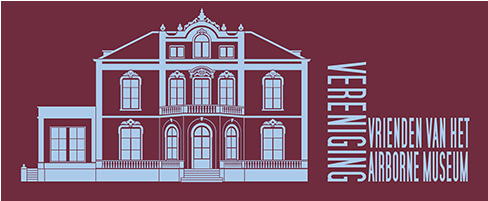
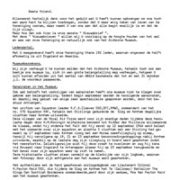
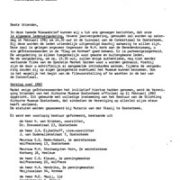
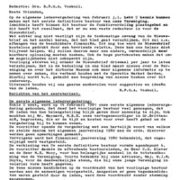
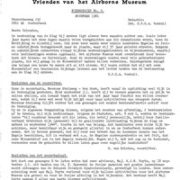
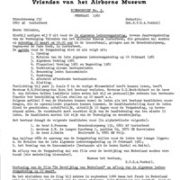
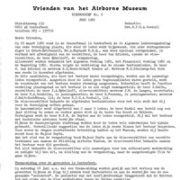
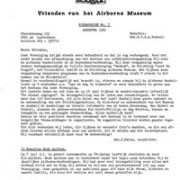
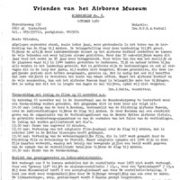
Plaats een Reactie
Vraag of reactie?Laat hier uw reactie achter.